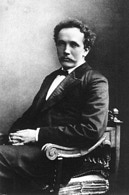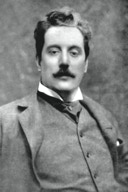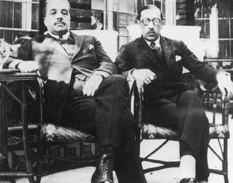
Maurice Ravel
(1875 - 1937)
Daphnis et Chloé, Suites 1 and 2
(1911-1913)
PROGRAM NOTES

“There must have been something magical in the air of Europe in the years 1909–1910,” Martin Bookspan declared in his television notes of Dec 31, 1998. He noted that Richard Strauss was working on Der Rosenkavalier, Igor Stravinsky was working on The Firebird, Schoenberg was “shaking up the establishment” with Five Pieces for Orchestra, Puccini was putting the finishing touches on The Girl of the Golden West, and enigmatic sounds were whirring in the head of Jean Sibelius which would become his Fourth Symphony. Musical creativity was alive and well on every front.
From left to right: Richard Strauss, Puccini, Stravinsky, Schoenberg, Sibelius. Ravel’s contemporaries were quite busy in the years 1909-10!
In 1909, the Russian Ballet swept into Paris, and stunned French audiences with their exciting and colorful ballets. In 1910, Sergei Diaghilev, the enterprising impresario, asked Ravel, then an up-and-coming talent, to write a ballet on the Greek legend of Daphnis and Chloé. In 1912 Ravel completed one of the most ravishingly beautiful scores ever written for the dance which he titled Choreographic Symphony.
Diaghilev and Stravinsky
The love story of Daphnis and Chloé was a classic, dating from the fourth or fifth century A.D. In 1559, a French translation by Amyot appeared, and in 1657 an English version by George Thornley titled “A Most Sweet and Pleasant Pastorall Romance for Young Ladies” became very popular.
Daphnis and Chloé, by Marc Chagall
However, the composer did not turn to classical Greece for his approach, explaining “My intention in writing it was to compose a vast musical fresco in which I was anxious less about archaism than fidelity to the Greece of my dreams, which is that which the French artists at the end of the eighteenth century imagined and painted. The work is constructed symphonically, according to a strict plan of key sequences, out of a small number of themes, the development of which ensures the music’s homogeneity.” This story was based on Fokine’s adaptation of a Longus fable and dedicated to Sergei Diaghilev.
When Ravel started his task he ensconced himself in Valvins, at the country home of his good friends, the Godebskis. He became so focused on the project that he did not even notice when the house flooded and the floor buckled! The project required three years. The final Bacchanale required a year to complete to his satisfaction. Igor Stravinsky confirmed that the time was well spent, “It is not only Ravel’s best work but one of the most beautiful products in all of French music.”
A contemporary paining of the Valvins area Ravel at work, with ubiquitous cigarette
Daphnis and Chloé is set in three tableaux.
1. The ballet opens on Mitylene on the island of Lesbos. A procession of boys and girls enters a meadow on the edge of a sacred grove, dominated by a huge rock in the form of Pan. The music is gentle and nebulous as they offer fruit and floral tributes to the nymphs sculpted in rock. Soon the music organizes itself into a solemn dance. Daphnis and Chloé appear. The action intensifies when Daphnis is challenged into a dance “contest” for Chloé by a goatherd (Dorcon). Dorcon’s music is wild and energetic; Daphnis’s is subtle and graceful, and he wins her affection. Chloé leaves the scene briefly and another young sensual woman tries to win Daphnis’ affection in a seductive dance, but he resists. Suddenly, Daphnis hears frightening news—there has been an invasion by pirates, and Chloé has been captured.
The two protagonists Chloé abducted by pirates
2. This section is based in the Pirates Camp. A warlike dance swirls onto the stage and Chloé is brought in and ordered to dance. Just as the Chief Pirate grabs her, a huge shadow of Pan is silhouetted against the mountain top, and the pirates flee.
3. This section returns us to a clearing in the wood. Daphnis is lying in front of the nymphs’ grotto, mourning his loss of Chloé as dawn is breaking. Birds sing and the sound of rushing water is heard as the light gently enters and grows into a luminous dawn. Happily, Daphnis learns that Pan did save Chloé because of the God’s personal memories of his own love for the nymph Syrinx. Upon Chloé’s return Daphnis and Chloé perform a dance representing that love. Then, they fall into each other’s arms and all join in a frenzied, joyful, spectacular Bacchanale.
Public reaction to the ballet was cool, as was Diaghilev’s reaction to the music, and the ballet opened and closed in two performances. The critic, Gaston Carraud, viewed the production as one of “deplorable confusion”; Pierre Lalo found Bakst’s conception of Greece unintelligible, and Fokine’s choreography “poor” and the music “lacking in rhythm.” Ravel explained the music’s ultimate success
“On the initial performance of a new musical composition, the first impression of the public is generally one of reaction to the more superficial elements of its music….it is not until years after when the means of expression have finally surrendered all their secrets that the real inner emotion of the music becomes apparent to the listener.”
Daphnis et Chloé has often been ranked as the finest ballet France ever produced. In Memoirs of a Ballet Master, Mikhail Fokine wrote “I loved the score from the first time I heard it.” For many of us that is very likely our initial and final reaction as well.
Two Suites were extracted from the ballet, and these have consistently met with success in the concert hall. The Second Suite consists of three movements played without pause: Lever du Jour (Daybreak) Pantomime (with a beautiful flute solo, referencing Syrinx who had been transformed into a reed pipe) and Danse Generale.











